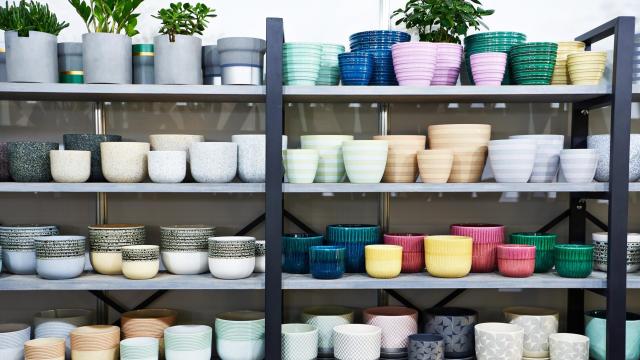Different pots have different uses for your home plants and planters. Plants behave differently in plastic containers than they do in glazed ceramic pots, and each pot has its own set of care instructions. So what is the difference between these various pots and planters? It comes down to breathability and moisture retention. Here are things to consider when looking for the perfect potted home for your plants.
What are the benefits of a plastic plant pot?
Plastic pots refer to the hard plastic pots you find at your local gardening or hardware store (not to be confused with the thin plastic planters that come with newly bought plants). The benefits of plastic pots are their ability to hold in moisture and their overall light weight.
Plant maintenance technician Paula Palma with Planters Place uses large plastic pots for her citrus plants. The lemon trees she plants need a large amount of room to grow, and she needs to be able to move the pots with ease. The high level of moisture retention of plastic pots is perfect for water-loving plants like ferns and orchids. Plastic containers are also very durable and will not break as easily as a ceramic pot may. An average plastic pot will run about $3.
When to choose a glazed ceramic pot
Ceramic pots can sometimes feel like terracotta, but they have stark differences in look and function. Both are porous clay, but ceramic pots are usually glazed, which changes their absorbing capabilities. The glaze keeps the soil from drying out as quickly as its terracotta cousin. Just be careful when moving a ceramic glazed pot — they can get fairly heavy once your plant is in.
Ceramic pots are great for spider plants, baby’s tears, and other plants that thrive with slow drainage. Glazed pots are also on the pricier end of the pot spectrum, costing about $US80 ($103) – $US150 ($192), depending on size and where you shop. Keep a lookout when selecting your pot — some don’t have the necessary drainage holes, so you’ll want to make sure you’re getting the right pot before buying.
Why choose terracotta pots?
Terracotta pots are known as fast-drying pots. The clay wicks water away from the inside, letting the potted soil dry faster than a plastic pot without porosity. The pot’s texture allows optimal airflow for the plants’ roots to thrive, and the quick dry prevents root rot.
Terracotta pots are perfect for succulents, cacti, and other desert plants. These porous pots may create the perfect drainage and growing environment, but they also break easily. These pots can cost anywhere from under a buck to $US10 ($13) or more, depending on the size you need.

Leave a Reply
You must be logged in to post a comment.